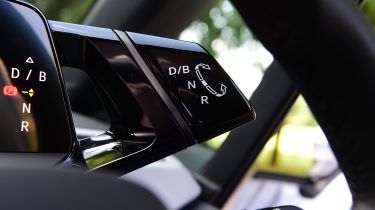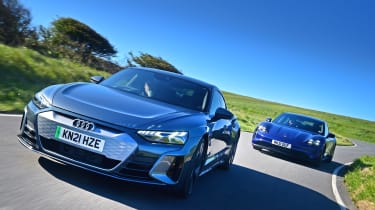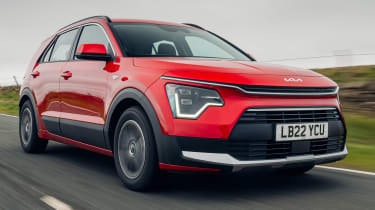Do electric cars have gearboxes?
Do electric cars have gears? Do they drive like an automatic car? Here's everything you need to know on the subject

Take a seat behind the wheel of any electric vehicle and you’ll quickly spot a gear selector somewhere about the cabin, similar to the one you’d find in a petrol or diesel car with an automatic gearbox. However, instead of a multi-speed gearbox, almost all electric cars, from the Fiat 500 city car up to the BMW i7 luxury limousine, only have a single gear.
Why do electric cars have only one gear?
There are many reasons why electric cars have only one gear. The first is that electric motors revolve (or 'rev') much faster than internal-combustion engines. A typical electric motor can rev at up to 20,000rpm – far higher than the 4,000-6,000rpm limit your typical petrol-powered road car can reach.
Also, electric motors are power-efficient throughout that rev range. This means they don't only deliver their optimum performance within a small, narrow band of revs. As a result, electric cars make maximum torque almost as soon as you put your foot down, so they don't have a specific rev range suited to low-speed driving or acceleration.
The reason conventional diesel and petrol cars need a gearbox with multiple gears is because these engines are only capable of generating usable torque and power within a narrow band of engine speed.
Varying gear ratios help conventional engines keep within that 'power band' at different road speeds. That’s why a petrol car will easily accelerate to 20mph in first gear, but won’t go much faster without reaching the engine’s rev limit, or 'redline'. By the same logic, you'll struggle to pull away from a set of lights in sixth gear, as this ratio is designed for cruising at motorway speeds.
Electric cars can reach top speed in a single gear, with little compromise in low-speed driving or usability. Engineers pick a gear ratio that strikes a good balance between acceleration and top speed. Pick a ratio too low, and the engine will accelerate very fast, but may be limited to a low top speed. Conversely, if engineers pick an extremely high ratio, the gearing may be optimal for high-speed runs, but acceleration suffers.

Can electric vehicles have more than one gear?
Yes, some electric cars buck the trend of relying on a single gear and do in fact use a multi-speed gearbox. The Porsche Taycan and Audi e-tron GT are the two main examples – both use a single-speed transmission for the front motor and a two-speed transmission for the rear motor.
This setup offers potential benefits for both performance and range in EVs. The first gear in the Porsche and Audi’s rear gearbox helps it launch quicker, but once they get onto the motorway, the cars automatically shift to the second gear for better high-speed driving and a higher top speed.
Suzuki is also working with Canadian company InMotive to develop a two-speed transmission for its new line-up of electric cars. According to InMotive, its patented technology can improve range and acceleration in electric cars by up to 15%. Suzuki is due to launch its first EV in Europe in 2024, but whether it’ll feature a two-speed gearbox hasn’t been confirmed yet.
Can I get an electric car with a manual gearbox?
No, not at the moment. But Toyota and Lexus are developing a simulated manual gearbox for use in electric cars, with the aim of providing the sensation of driving a traditional stick-shift manual.
However, the system doesn’t include any physical gears at all, nor does it involve Toyota sticking anything to the back-end of an electric motor. Instead, shifts are simulated electronically, with the car limiting power output through each gear artificially to try and emulate the power delivery of a combustion engine. Vibrations transmitted to the fake clutch pedal aim to make the whole thing feel more mechanical, while sound generators in the cabin will complete the experience.
Lexus, who is taking a leading role in the development of Toyota’s high-performance electric cars, has now installed this simulated manual setup in a prototype based on the UX 300e compact SUV. But it’s unclear when you’ll see a system like this in an EV on showroom floors.

Does that mean hybrid cars have an electric motor with more than one gear?
Most hybrids (plug-in or otherwise) have a standard electric motor with a single gear, as this is cheaper and less complicated to manufacture. And as explained above, single-geared units give away very little in terms of performance or efficiency, mitigating the need for a two or three-speed gearbox. The internal-combustion engine in these cars will usually put its power through a conventional automatic or CVT automatic gearbox.
What are the benefits of having just a single gear?
From a manufacturing point of view, the biggest benefits of having just a single gear for an electric motor are cost and simplicity. Installing a driveline system with multiple gears immediately adds cost and complexity, which increases the car's price.
Given that electric cars tend to cost more than their diesel and petrol counterparts, manufacturers are going to try and avoid unnecessarily adding to their EV’s price tags. This is especially true when the single-gear setup is already optimal for most electric cars, and delivers equal or even better performance than conventional powertrains can offer.
